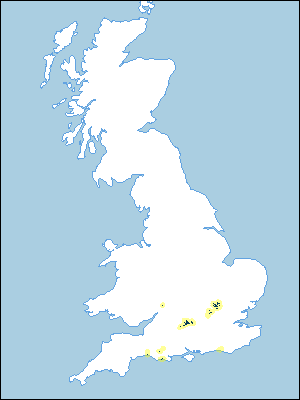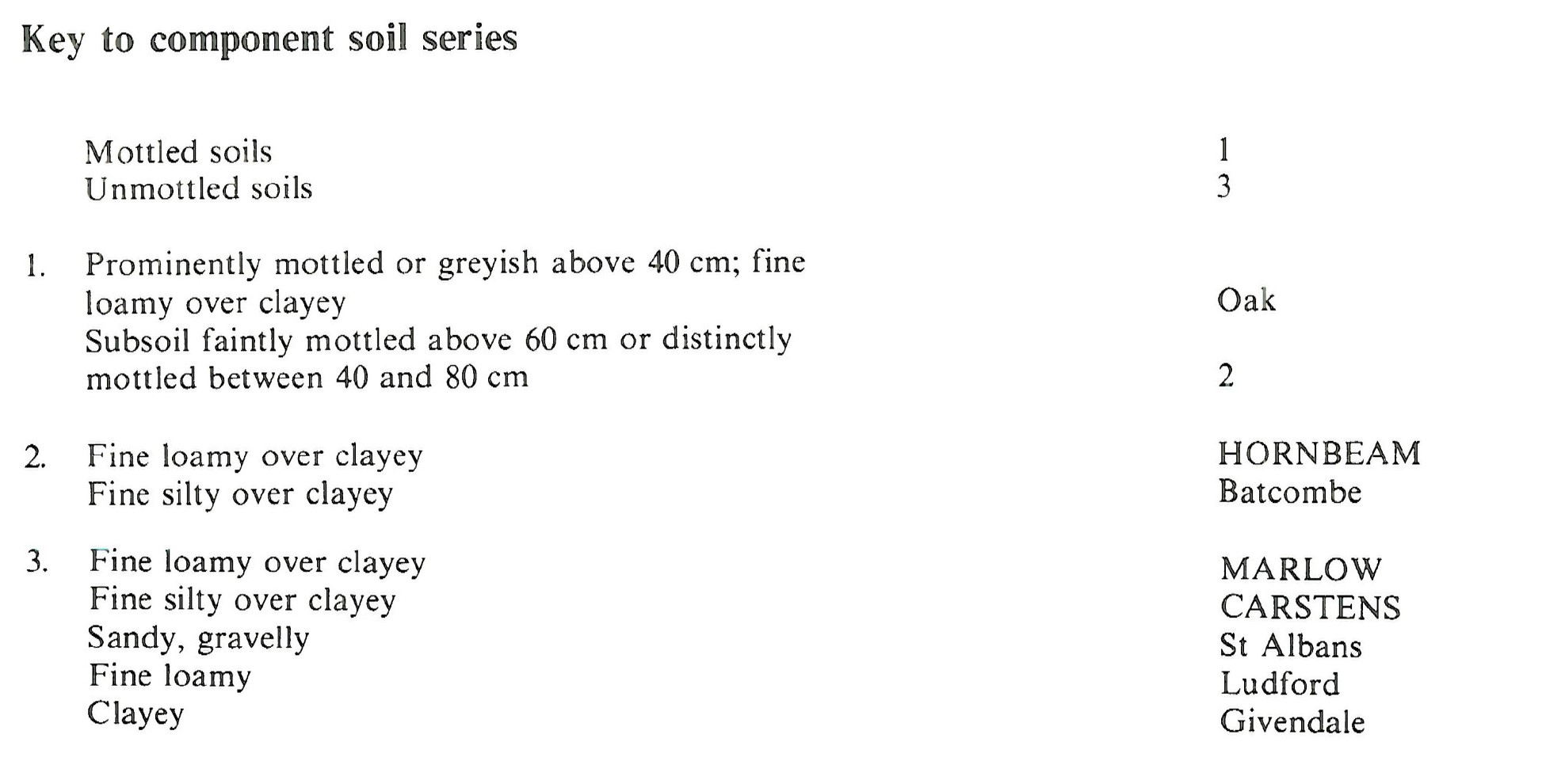
Soil Associations
0582c HORNBEAM 2
Soil and site characteristics
Deep fine loamy over clayey soils with slowly permeable subsoils and slight seasonal waterlogging. Some well drained fine loamy and fine silty over clayey and clayey soils. Some soils very flinty.
Geology
Plateau drift
Cropping and Land Use
Cereals and grassland rotations in Hertfordshire; much grassland with dairying in moist districts.
Component soil series
| Subgroup | Series name | Percentage | WRB 2006 link |
|---|---|---|---|
| 5.82 | HORNBEAM | 50% | Profundic Chromic Endostagnic Luvisols |
| 5.81 | MARLOW | 20% | Profundic Chromic Luvisols |
| 5.81 | CARSTENS | 10% | Profundic Chromic Luvisols |
Covers 300 km2 in England and Wales
Soilscapes Classification
| 8 |
Slightly acid loamy and clayey soils with impeded drainage |
0582c HORNBEAM 2
Detailed Description
All land in this association is over thick clayey Plateau Drift and Clay-with-flints on gently sloping chalkland in Dorset, Berkshire, Buckinghamshire and Hertfordshire. The flinty red and grey mottled clays are, in turn, overlain by thin loamy drift. The principal soil, fine loamy over clayey Hornbeam series is a stagnogleyic paleo-argillic brown earth. Ancillary soils include the well drained loamy and silty over clayey Marlow and Carstens series, typical paleo-argillic brown earths. Where the superficial loamy drift is absent clayey Givendale soils occur in reddish flinty clayey drift. Less permeable Plateau Drift gives rise to fine loamy over clayey Oak soils. Small inclusions of a wide range of other soils are also present and there is some regional variation in the distribution of the minor soils listed in the key.
The association occurs on gently sloping ground on the lower Chiltern dipslope at 100 to 150 m O.D. between Baldock and Chorleywood. Marlow and Givendale series are dominant around Welwyn Garden City and Baldock. Small inclusions of wetter Oak soils are found, often in woodland. Deep, loamy well drained Ludford soils occur where the loamy drift is thickest, either over clay or chalk. Where the drift is thin over the underlying chalk, the soils include Rudham and Andover series, with Upton series on steeper slopes, and Soham series locally on gentle slopes and in valleys. Charity seriesoccurs where valleys are floored by thick fine silty drift.
In Dorset the association occurs on Plateau Drift capping the gently sloping higher chalk Downs between 200 and 300 m O.D. and on the south coast. Marlow and Carstens soils are common associates where the brown upper layers are fine loamy or fine silty respectively, and there are some Oak soils. In west Dorset the association is found on the tops of small hills where Plateau Drift overlies Upper Greensand; here Oak series is the main associate soil. Small patches also occur in the upper Kennet valley east of Savernake Forest. The loamy upper horizons of most of the constituent soils are in part derived from the remains of sandy and loamy Tertiary deposits. Loamy soils of the Bursledon and Curdridge series can be found where the loamy drift thickens locally. The small areas mapped on high terraces of the river Severn near Woolridge and Maisemore were formerly described as Norton series.
On the Berkshire Downs the association occurs where Plateau Drift caps the Chalk at 125 to 230 m O.D. Here it was mapped as Berkhamsted association, and well drained clayey Givendale and fine silty over clayey Carstens soils are common associates. Locally Marlow, St Albans or Sonning and Batcombe series are present. St Albans and Sonning soils are developed in stony, sandy and coarse loamy drift. Small areas of Shedfield, Bursledon and Wickham soils are associated with patches of disturbed Reading Beds. Calcareous Soham and Rudham soils are present in the heads of dry valleys and on some steeper slopes.
Soil Water Regime
Hornbeam soils have slowly permeable coarsely structured clay subsoils which cause periodic waterlogging during the winter (Wetness Class II or III). Oak soils lie wet throughout the winter (Wetness Class III). Carstens, Givendale and Marlow soils are relatively permeable and rarely waterlogged (Wetness Class I).
Cropping and Land Use
In the Hertfordshire climate there are long periods available for autumn landwork even in wet years. In spring there is less time available and opportunities are particularly restricted on Oak soils. Hornbeam and Marlow soils are locally very flinty, hindering cultivations and causing excessive wear to implements and farm machinery. Most land is under cereals, mainly winter sown, with a break crop of oilseed rape. There is some grassland for dairying and deciduous woodland is common, clothing much of the high ground. Most of the soils are slightly droughty for arable crops though moderately droughty for potatoes. All component soils are moderately to very droughty for grass. Ludford, Carstens, Soham and Marlow soils generally produce better yields of a wider range of crops than Hornbeam and Oak soils because of their better natural drainage.
0582c HORNBEAM 2
Distribution Map
 |
Note that the yellow shading represents a buffer to highlight the location of very small areas of the association.
Keys to component soil series
Eastern Region
 |
South Eastern Region
 |
Typical Landscapes
Eastern Region
 |
All information Copyright, Cranfield University © 2024
Citation: To use information from this web resource in your work, please cite this as follows:
Cranfield University 2024. The Soils Guide. Available: www.landis.org.uk. Cranfield University, UK. Last accessed 19/04/2024
